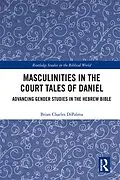In this volume, Brian Charles DiPalma examines masculinities in the court tales of Daniel as a test case for issues facing the burgeoning area of gender studies in the Hebrew Bible. In doing so, it both analyses how the court tales of Daniel portray the characters in terms of configurations of masculinity in their socio-historical context, and also seeks to advance gender studies in the Hebrew Bible on theoretical, methodological, and political grounds.
Masculinities in the Court Tales of Daniel is therefore of interest not only to scholars working on Daniel, but also biblical scholars studying gender in the Hebrew Bible more broadly, including those engaged in feminist criticism, queer criticism, and studies of masculinity, as well as anyone studying gender within an ancient Near Eastern context.
Autorentext
Brian Charles DiPalma is an independent scholar, currently teaching in Fresno, California, USA.
Inhalt
List of Figures
Acknowledgements
Chapter One - Introduction
- Introduction
- Contextualizing this Study in Biblical Scholarship
- Goals, Argument Summary, and Outline
Chapter Two - Issues for Gender Studies in the Hebrew Bible
2.1 Introduction
2.2 The Issues
2.2.1 A Question of Method: How to Study Gender in Biblical Literature?
2.2.2 Disciplinary Fit of Studies of Masculinity
2.2.3 Political Implications of Masculinity Studies
2.2.4 What Happens When Characters Deviate from Gendered Norms?
2.3 Summary
Chapter Three - On Gender and Masculinity: Framing the Case Study
3.1 Introduction
3.2 Studying Gender in Biblical Literature Informed by Sociological Perspectives
3.3 Doing Gender in Sociological Scholarship
3.4 Masculinities
3.5 Concluding Comments
Chapter Four - Masculinity in the Court Tales of Daniel: Identifying the Issues
4.1 Introduction
4.2 Hypotheses about Masculinity in the Court Tales of Daniel
4.2.1 Daniel 1 - Competing Masculinities: Braun Versus Beauty and Brains
4.2.2 Daniel 2 - The Power of Knowledge
4.2.3 Daniel 3 - The King's Erect Statue: A Ritual of Subordination Gone Awry
4.2.4 Daniel 4 - Is Nebuchadnezzar Good at Being a Male Ruler?
4.2.5 Daniel 5 - Belshazzar and the Problem (of) Son(s)
4.2.6 Daniel 6 - Repetition and Its Significance
4.3 Summary of Hypotheses
Chapter Five - A Predominant Masculinity and the Court Tales of Daniel
5.1 Introduction
5.2 Sources for Testing the Hypotheses
5.3 A Culturally Predominant Masculinity
5.3.1 Violence, Power, and Masculinity
5.3.2 Producing Sons, Names, and Masculinity
5.3.3 Protection, Provision, and Masculinity
5.4 Conclusions
Chapter Six - Scribal Masculinity and the Court Tales of Daniel
6.1 Introduction
6.2 Scribal Masculinity in the Ancient Near East and the Hebrew Bible
6.3 Conclusions
Chapter Seven - Beauty, Masculinity, and the Court Tales of Daniel
7.1 Introduction
7.2 Approaching Beauty and Masculinity
7.3 Beauty and the Court Tales of Daniel
7.4 Conclusions
Chapter Eight - Discourse, Masculinity, and the Court Tales of Daniel
8.1 Introduction
8.2 Beyond Persuasion: Problems with "Persuasive Speech"
8.3 Another Approach: Using Discourse to Do Gender
8.4 Discourse and Masculinity in the Court Tales of Daniel
8.5 Conclusions
Chapter Nine - Advancing Gender Studies in the Hebrew Bible
9.1 Introduction
9.2 Summary of Argument and Areas for Future Research
9.3 Revisiting the Issues
9.3.1 A Question of Method: How to Study Gender in Biblical Literature?
9.3.2 What Happens When a Narrative Character Deviates from Culturally Predominant Norms of Gender?
9.3.3 Political Implications of a Study of Masculinity in Biblical Literature
9.3.4 Disciplinary Fit of a Study of Masculinity in Biblical Literature
Bibliography
Index
